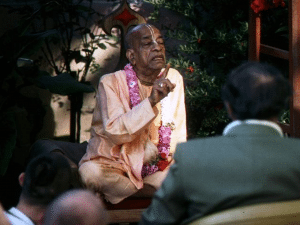SP 2nd album
Prabhupada's second record album, which had been recorded and produced by Dinesh, is released mid-March. The album sweeps throughout ISKCON like wild-fire. In London the devotees have it played on the BBC and Mukunda describes it as "super-excellent". In Hawaii, Govinda dasi arranges a radio interview for Prabhupada, and during the show tracks from the album are featured. At Prabhupada's request, Dinesh had also recorded Vishnujana chanting, with Srila Prabhupada himself playing along on mridanga. Although the Vishnujana track is not released as part of Prabhupada's album, nevertheless Prabhupada keeps a copy of the recording for himself. He likes to listen to Vishnujana chant, with the Los Angeles Yatra responding so devotionally.
After Prabhupada leaves for Hawaii, Tamal Krishna begins to make improvements to the temple. Prabhupada had authorized him to fix up the prasadam hall, since 70-80 guests are now coming regularly every Sunday. Enhancing the facilities will increase the number of guests. Lord Jagannath is still the main Deity in every ISKCON temple, accepting the service of the young American Vaishnavas. His presence has become quite prominent since His initial arrival through Malati. But Radha and Krishna are also beginning to make Their appearance in ISKCON.
"When we first start a temple, we start with Jagannath Swami. My Guru Maharaja recommended temples of Jagannath in these countries, so I was inspired to establish first of all Jagannath Swami because He is kind even to the mlecchas. Then, when there is opportunity, I establish Radha-Krishna murti. So generally in all our temples, Jagannath Swami and Lord Caitanya sankirtana pictures are invariably there, and gradually we are installing Radha-Krishna murtis in each and every center." (Letter to Hanuman Prasad Poddar, February 5, 1970)
When Sri Sri Radha-Krishna make Their appearance in Boston. Prabhupada instructs Satsvarupa how to perform the abhisheka during the installation ceremony. He also explains the proper attitude of worship.
"Radha-Krishna is worshipped in Vrindavana, which is like a simple village, but we worship Lakshmi-Narayana, and the worship is accepted by the Radha-Krishna Deity. Actually, in our present status, we cannot worship Radha-Krishna. But as all the Vishnu murtis are situated in Krishna, therefore, our Radha-Krishna worship is transferred to Vishnu, Lord Narayana. Vishnu worship, is the regulative devotional principles, and Radha-Krishna worship is spontaneous service of eternal feelings. Therefore, as Lakshmi-Narayana is the Deity of great opulence, similarly our Radha-Krishna murtis also should be worshipped with great pomp and dignity." (Letter to Satsvarupa, February 12, 1969)
Now that Radha and Krishna are in New York and Boston, the Los Angeles devotees are anxiously waiting for their own Radha-Krishna Deities to arrive from India. Muralidhara draws a lovely design for a simhasana that he sends to Hawaii for Prabhupada's approval. Prabhupada appreciates Muralidhara's design and authorizes Tamal to fund its construction.
In Honolulu not many engagements have been arranged, so Prabhupada utilizes his time writing "Nectar of Devotion" and "KRISHNA" book. Since the temple has only been functioning a few months, just one new devotee, Balabhadra, is initiated before Srila Prabhupada leaves for San Francisco on March 31. After a week in San Francisco, he will return to Los Angeles for an initiation and marriage ceremony over the Easter Sunday weekend, before leaving again for New York and the East Coast temples. Anticipating Srila Prabhupada's arrival in LA, there is a flurry of excitement and activity as devotees scramble around to ensure everything is in tip-top shape. Jayananda is still the groundskeeper and wants to be sure the gardens will look beautiful for his spiritual master. A detail of new bhaktas is assigned to help Jayananda dig new flower beds and clean up the grounds in preparation for Prabhupada's return. As they work side-by-side, Jayananda is always preaching and giving instructions on the process of Krishna consciousness. He particularly stresses the point of remaining determined in spite of obstacles on the path.
Karandhara: He was talking about not becoming discouraged by setbacks. I recall in my mind's eye one image of Jayananda from that day. He had momentarily stopped shoveling the dirt and stood there looking at the horizon and said, "You know, things don't always go right in Krishna consciousness. You have to keep chanting." It was the sincerity of the remark which impressed me. He was the type of personality to whom I felt an automatic attraction as a person. It wasn't so much his having any overt charisma about him. He was large in body, not heavy, but tall and husky with a very gentle face and very diminutive type of demeanor. I felt immediately comfortable in his presence. He wasn't at all pretentious; he wasn't anxious about presenting himself in any manner. He was relaxed and sincere about everything he did.
These are pioneering days for Krishna consciousness in the West, and in the excitement of spreading the word, the quiet devotees are often overlooked. Jayananda's significance in the temple is more expressed by his inconspicuous service than anything else. He is never prominent, nor does he have any ambition to be recognized as senior. Always very active and engaged in practical work, he does his service with enthusiasm and energy. One never hears criticism or complaints uttered from Jayananda's lips. Rather he is the quiet foundation of the temple, whom everyone depends on, though hardly anyone realizes his importance.
